Particle-Scale Simulation of Solid Mixing Characteristics of Binary Particles in a Bubbling Fluidized Bed
Abstract
1. Introduction
2. Methodology
2.1. Governing Equations for the Fluid Phase
2.2. Governing Equations for the Particle Phase
3. Computational Details
3.1. Numerical Setups
3.2. Initial and Boundary Conditions
4. Results and Discussion
4.1. Model Validation
4.2. General Flow Pattern in the Binary Bubbling Fluidized Bed
4.3. Influence of Superficial Velocity on the Solid Mixing
4.4. Influence of SMD on the Solid Mixing
4.5. Influence of Particle Size Distribution on the Solid Mixing
5. Conclusions
Author Contributions
Funding
Conflicts of Interest
References
- Yang, S.; Zhou, T.; Wei, Y.; Hu, J.; Wang, H. Influence of size-induced segregation on the biomass gasification in bubbling fluidized bed with continuous lognormal particle size distribution. Energy Convers. Manag. 2019, 198, 111848. [Google Scholar] [CrossRef]
- Hofer, G.; Märzinger, T.; Eder, C.; Pröll, F.; Pröll, T. Particle mixing in bubbling fluidized bed reactors with continuous particle exchange. Chem. Eng. Sci. 2019, 195, 585–597. [Google Scholar] [CrossRef]
- Zhao, G.; Shi, X.; Wu, Y.; Wang, M.; Zhang, M.; Gao, J.; Lan, X. 3D CFD simulation of gas-solids hydrodynamics and bubbles behaviors in empty and packed bubbling fluidized beds. Powder Technol. 2019, 351, 1–15. [Google Scholar] [CrossRef]
- Timmer, K.J.; Brown, R.C. Transformation of char carbon during bubbling fluidized bed gasification of biomass. Fuel 2019, 242, 837–845. [Google Scholar] [CrossRef]
- Chew, J.W.; Hrenya, C.M. Link between bubbling and segregation patterns in gas-fluidized beds with continuous size distributions. AlChE J. 2011, 57, 3003–3011. [Google Scholar] [CrossRef]
- Yiannoulakis, H.; Yiagopoulos, A.; Kiparissides, C. Recent developments in the particle size distribution modeling of fluidized-bed olefin polymerization reactors. Chem. Eng. Sci. 2001, 56, 917–925. [Google Scholar] [CrossRef]
- Gu, J.; Zhong, W.; Yu, A. Three-dimensional simulation of oxy-fuel combustion in a circulating fluidized bed. Powder Technol. 2019, 351, 16–27. [Google Scholar] [CrossRef]
- Bidabadi, M.; Bozorg, M.V.; Bordbar, V.; Ahmadi, G. Flame propagation through heterogeneous combustion of hybrid aluminum-boron poly-disperse particle suspensions in air. Fuel 2018, 215, 714–725. [Google Scholar] [CrossRef]
- Deen, N.G.; Kuipers, J.A.M. Direct Numerical Simulation (DNS) of mass, momentum and heat transfer in dense fluid-particle systems. Curr. Opin. Chem. Eng. 2014, 5, 84–89. [Google Scholar] [CrossRef]
- Marandi, R.; Hashim, S.; Zahedi, G. Hydrodynamic and Heat Transfer Modeling of Polydisperse Fluidized Bed Olefin Polymerization Reactors. In Computer Aided Chemical Engineering; Elsevier: Amsterdam, The Netherlands, 2012; Volume 30, pp. 1053–1057. [Google Scholar]
- Wang, S.; Luo, K.; Fan, J. CFD-DEM coupled with thermochemical sub-models for biomass gasification: Validation and sensitivity analysis. Chem. Eng. Sci. 2020, 217, 115550. [Google Scholar] [CrossRef]
- Wang, S.; Luo, K.; Hu, C.; Fan, J. CFD-DEM study of the effect of cyclone arrangements on the gas-solid flow dynamics in the full-loop circulating fluidized bed. Chem. Eng. Sci. 2017, 172, 199–215. [Google Scholar] [CrossRef]
- Yang, S.; Cahyadi, A.; Sun, Y.; Wang, J.; Chew, J.W. CFD-DEM investigation into the scaling up of spout-fluid beds via two interconnected chambers. AlChE J. 2016, 62, 1898–1916. [Google Scholar] [CrossRef]
- Yang, X.; Wang, S.; Li, B.; Liu, H.; He, Y. Evaluation of sorption-enhanced reforming over catalyst-sorbent bi-functional particles in an internally circulating fluidized bed. Adv. Powder Technol. 2020, 31, 2566–2572. [Google Scholar] [CrossRef]
- Wang, S.; Luo, K.; Hu, C.; Sun, L.; Fan, J. Effect of superficial gas velocity on solid behaviors in a full-loop CFB. Powder Technol. 2018, 333, 91–105. [Google Scholar] [CrossRef]
- Yang, S.; Wang, H.; Wei, Y.; Hu, J.; Chew, J.W. Numerical Investigation of Bubble Dynamics during Biomass Gasification in a Bubbling Fluidized Bed. ACS Sustain. Chem. Eng. 2019, 7, 12288–12303. [Google Scholar] [CrossRef]
- Alobaid, F. A particle-grid method for Euler-Lagrange approach. Powder Technol. 2015, 286, 342–360. [Google Scholar] [CrossRef]
- Lim, L.J.J.; Lim, E.W.C. Mixing and segregation behaviors of a binary mixture in a pulsating fluidized bed. Powder Technol. 2019, 345, 311–328. [Google Scholar] [CrossRef]
- Molaei, E.A.; Yu, A.; Zhou, Z. CFD-DEM modelling of mixing and segregation of binary mixtures of ellipsoidal particles in liquid fluidizations. J. Hydrodyn. 2019, 31, 1190–1203. [Google Scholar] [CrossRef]
- Huilin, L.; Yurong, H.; Gidaspow, D. Hydrodynamic modelling of binary mixture in a gas bubbling fluidized bed using the kinetic theory of granular flow. Chem. Eng. Sci. 2003, 58, 1197–1205. [Google Scholar] [CrossRef]
- Dash, S.; Mohanty, S.; Mishra, B.K. CFD modelling and simulation of an industrial scale continuous fluidized bed roaster. Adv. Powder Technol. 2020, 31, 658–669. [Google Scholar] [CrossRef]
- Yang, S.; Liu, X.; Wang, S. CFD simulation of air-blown coal gasification in a fluidized bed reactor with continuous feedstock. Energy Convers. Manag. 2020, 213, 112774. [Google Scholar] [CrossRef]
- Goldschmidt, M.J.V.; Link, J.M.; Mellema, S.; Kuipers, J.A.M. Digital image analysis measurements of bed expansion and segregation dynamics in dense gas-fluidised beds. Powder Technol. 2003, 138, 135–159. [Google Scholar] [CrossRef]
- Huilin, L.; Yurong, H.; Gidaspow, D.; Lidan, Y.; Yukun, Q. Size segregation of binary mixture of solids in bubbling fluidized beds. Powder Technol. 2003, 134, 86–97. [Google Scholar] [CrossRef]
- Zhang, Y.; Jin, B.; Zhong, W. Experimental investigation on mixing and segregation behavior of biomass particle in fluidized bed. Chem. Eng. Process. Process. Intensif. 2009, 48, 745–754. [Google Scholar] [CrossRef]
- Zhong, H.; Gao, J.; Xu, C.; Lan, X. CFD modeling the hydrodynamics of binary particle mixtures in bubbling fluidized beds: Effect of wall boundary condition. Powder Technol. 2012, 230, 232–240. [Google Scholar] [CrossRef]
- Cooper, S.; Coronella, C.J. CFD simulations of particle mixing in a binary fluidized bed. Powder Technol. 2005, 151, 27–36. [Google Scholar] [CrossRef]
- Zhou, Q.; Wang, J. CFD study of mixing and segregation in CFB risers: Extension of EMMS drag model to binary gas–solid flow. Chem. Eng. Sci. 2015, 122, 637–651. [Google Scholar] [CrossRef]
- Fan, R.; Fox, R.O. Segregation in polydisperse fluidized beds: Validation of a multi-fluid model. Chem. Eng. Sci. 2008, 63, 272–285. [Google Scholar] [CrossRef]
- Van Sint Annaland, M.; Bokkers, G.A.; Goldschmidt, M.J.V.; Olaofe, O.O.; van der Hoef, M.A.; Kuipers, J.A.M. Development of a multi-fluid model for poly-disperse dense gas-solid fluidised beds, part II: Segregation in binary particle mixtures. Chem. Eng. Sci. 2009, 64, 4237–4246. [Google Scholar] [CrossRef]
- Zhang, Y.; Zhao, Y.; Lu, L.; Ge, W.; Wang, J.; Duan, C. Assessment of polydisperse drag models for the size segregation in a bubbling fluidized bed using discrete particle method. Chem. Eng. Sci. 2017, 160, 106–112. [Google Scholar] [CrossRef]
- Limtrakul, S.; Chalermwattanatai, A.; Unggurawirote, K.; Tsuji, Y.; Kawaguchi, T.; Tanthapanichakoon, W. Discrete particle simulation of solids motion in a gas-solid fluidized bed. Chem. Eng. Sci. 2003, 58, 915–921. [Google Scholar] [CrossRef]
- Cundall, P.A.; Strack, O.D. A discrete numerical model for granular assemblies. Geotechnique 1979, 29, 47–65. [Google Scholar] [CrossRef]
- Luo, K.; Wu, F.; Yang, S.; Fang, M.; Fan, J. High-fidelity simulation of the 3-D full-loop gas-solid flow characteristics in the circulating fluidized bed. Chem. Eng. Sci. 2015, 123, 22–38. [Google Scholar] [CrossRef]
- Yang, S.L.; Luo, K.; Fang, M.M.; Zhang, K.; Fan, J.R. Numerical investigation of the gas-solid flow characteristics in a three-dimensional spouted bed with a draft tube. Chem. Eng. Technol. 2013, 36, 2035–2043. [Google Scholar] [CrossRef]
- Wang, S.; Luo, K.; Hu, C.; Lin, J.; Fan, J. CFD-DEM simulation of heat transfer in fluidized beds: Model verification, validation, and application. Chem. Eng. Sci. 2019, 197, 280–295. [Google Scholar] [CrossRef]
- Luo, K.; Lin, J.; Wang, S.; Hu, C.; Fan, J. Effect of operating parameters on gas-solid hydrodynamics and heat transfer in a spouted bed. Chem. Eng. Technol. 2019, 42, 2310–2320. [Google Scholar] [CrossRef]
- Beetstra, R.; van der Hoef, M.A.; Kuipers, J.A.M. Drag force of intermediate Reynolds number flow past mono- and bidisperse arrays of spheres. AlChE J. 2007, 53, 489–501. [Google Scholar] [CrossRef]
- Beetstra, R.; van der Hoef, M.A.; Kuipers, J.A.M. Numerical study of segregation using a new drag force correlation for polydisperse systems derived from lattice—Boltzmann simulations. Chem. Eng. Sci. 2007, 62, 246–255. [Google Scholar] [CrossRef]
- Jiang, Z.; Hagemeier, T.; Bück, A.; Tsotsas, E. Color-PTV measurement and CFD-DEM simulation of the dynamics of poly-disperse particle systems in a pseudo-2D fluidized bed. Chem. Eng. Sci. 2018, 179, 115–132. [Google Scholar] [CrossRef]
- Wang, S.; Luo, K.; Yang, S.; Hu, C.; Fan, J. Parallel LES-DEM simulation of dense flows in fluidized beds. Appl. Therm. Eng. 2017, 111, 1523–1535. [Google Scholar] [CrossRef]
- Peng, Z.; Doroodchi, E.; Luo, C.; Moghtaderi, B. Influence of void fraction calculation on fidelity of CFD-DEM simulation of gas-solid bubbling fluidized beds. AlChE J. 2014, 60, 2000–2018. [Google Scholar] [CrossRef]
- Clarke, D.A.; Sederman, A.J.; Gladden, L.F.; Holland, D.J. Investigation of void fraction schemes for use with CFD-DEM simulations of fluidized beds. Ind. Eng. Chem. Res. 2018, 57, 3002–3013. [Google Scholar] [CrossRef]
- Tsuji, Y.; Kawaguchi, T.; Tanaka, T. Discrete particle simulation of two-dimensional fluidized bed. Powder Technol. 1993, 77, 79–87. [Google Scholar] [CrossRef]
- Lacey, P.M.C. Developments in the theory of particle mixing. J. Appl. Chem. 1954, 4, 257–268. [Google Scholar] [CrossRef]
- Feng, Y.Q.; Xu, B.H.; Zhang, S.J.; Yu, A.B.; Zulli, P. Discrete particle simulation of gas fluidization of particle mixtures. AlChE J. 2004, 50, 1713–1728. [Google Scholar] [CrossRef]
- Wang, S.; Luo, K.; Hu, C.; Sun, L.; Fan, J. Impact of operating parameters on biomass gasification in a fluidized bed reactor: An Eulerian-Lagrangian approach. Powder Technol. 2018, 333, 304–316. [Google Scholar] [CrossRef]
- Fang, M.; Luo, K.; Yang, S.; Zhang, K.; Fan, J. Computational fluid dynamics—Discrete element method investigation of solid mixing characteristics in an internally circulating fluidized bed. Ind. Eng. Chem. Res. 2013, 52, 7556–7568. [Google Scholar] [CrossRef]
- Yang, S.; Sun, Y.; Zhang, L.; Zhao, Y.; Chew, J.W. Numerical investigation on the effect of draft plates on spouting stability and gas-solid characteristics in a spout-fluid bed. Chem. Eng. Sci. 2016, 148, 108–125. [Google Scholar] [CrossRef]
- Wang, S.; Luo, K.; Hu, C.; Fan, J. CFD-DEM study of the effect of ring baffles on system performance of a full-loop circulating fluidized bed. Chem. Eng. Sci. 2019, 196, 130–144. [Google Scholar] [CrossRef]
- Hu, C.; Luo, K.; Yang, S.; Wang, S.; Fan, J. A comprehensive numerical investigation on the hydrodynamics and erosion characteristics in a pressurized fluidized bed with dense immersed tube bundles. Chem. Eng. Sci. 2016, 153, 129–145. [Google Scholar] [CrossRef]
- Wang, S.; Lu, H.; Zhao, F.; Liu, G. CFD studies of dual circulating fluidized bed reactors for chemical looping combustion processes. Chem. Eng. J. 2014, 236, 121–130. [Google Scholar] [CrossRef]
- Shuai, W.; Huang, L.; Zhenhua, H.; Huilin, L.; Guodong, L.; Dan, L.; Feixiang, Z. Numerical modeling of a bubbling fluidized bed coal gasifier by kinetic theory of rough spheres. Fuel 2014, 130, 197–202. [Google Scholar] [CrossRef]
- Sun, L.; Luo, K.; Fan, J. Numerical investigation on methanation kinetic and flow behavior in full-loop fluidized bed reactor. Fuel 2018, 231, 85–93. [Google Scholar] [CrossRef]
- Su, M.; Zhao, H.; Ma, J. Computational fluid dynamics simulation for chemical looping combustion of coal in a dual circulation fluidized bed. Energy Convers. Manag. 2015, 105, 1–12. [Google Scholar] [CrossRef]
- Lin, J.; Luo, K.; Sun, L.; Wang, S.; Hu, C.; Fan, J. Numerical investigation of nickel-copper oxygen carriers in chemical-looping combustion process with zero emission of CO and H2. Energy Fuels 2019, 33, 12096–12105. [Google Scholar] [CrossRef]
- Duan, Y.; Duan, L.; Wang, J.; Anthony, E.J. Observation of simultaneously low CO, NOx and SO2 emission during oxy-coal combustion in a pressurized fluidized bed. Fuel 2019, 242, 374–381. [Google Scholar] [CrossRef]
- Sutardi, T.; Paul, M.C.; Karimi, N. Investigation of coal particle gasification processes with application leading to underground coal gasification. Fuel 2019, 237, 1186–1202. [Google Scholar] [CrossRef]
- Chen, H.; Cheng, M.; Liu, L.; Li, Y.; Li, Z.; Cai, N. Coal-fired chemical looping combustion coupled with a high-efficiency annular carbon stripper. Int. J. Greenh. Gas. Control. 2020, 93, 102889. [Google Scholar] [CrossRef]
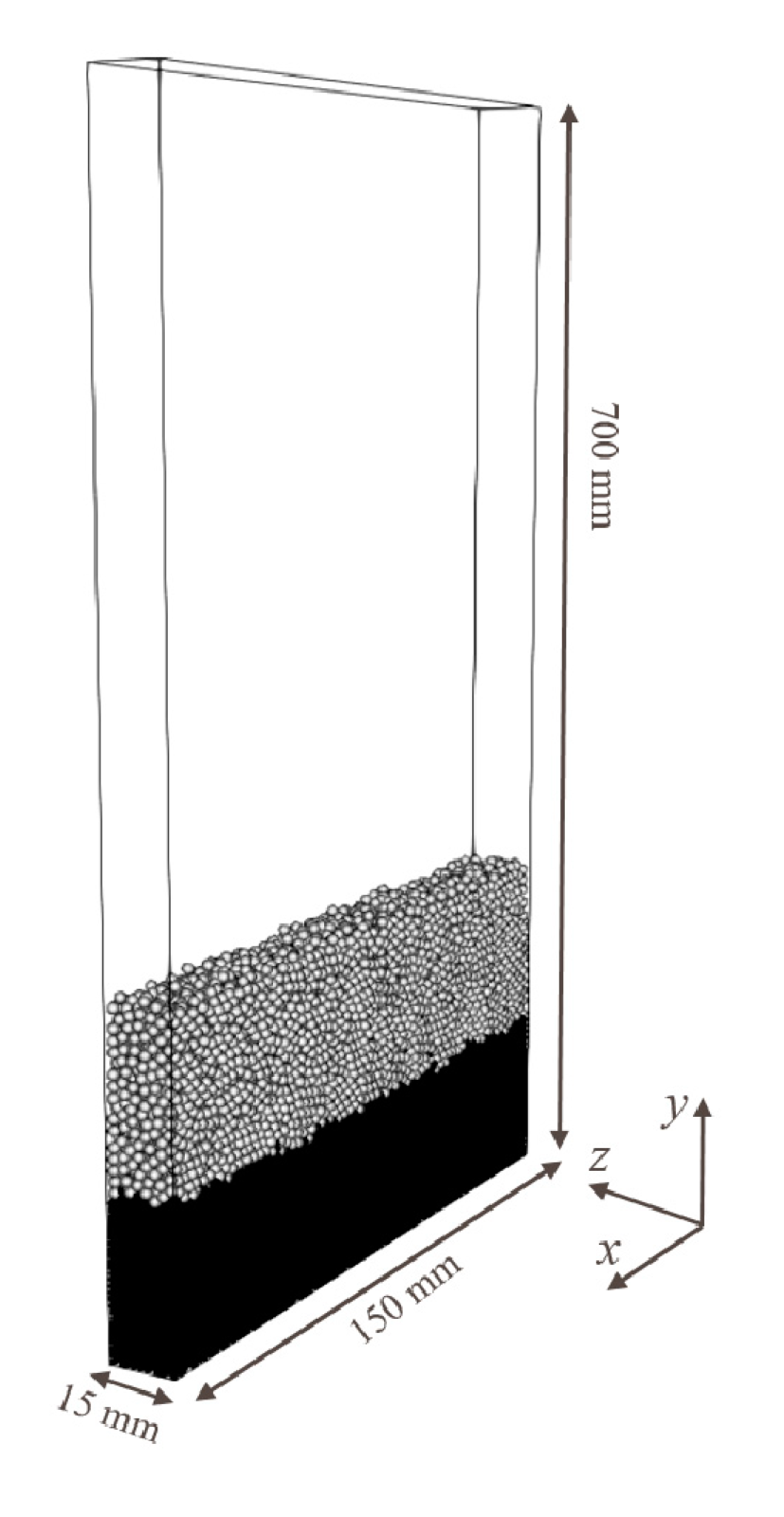
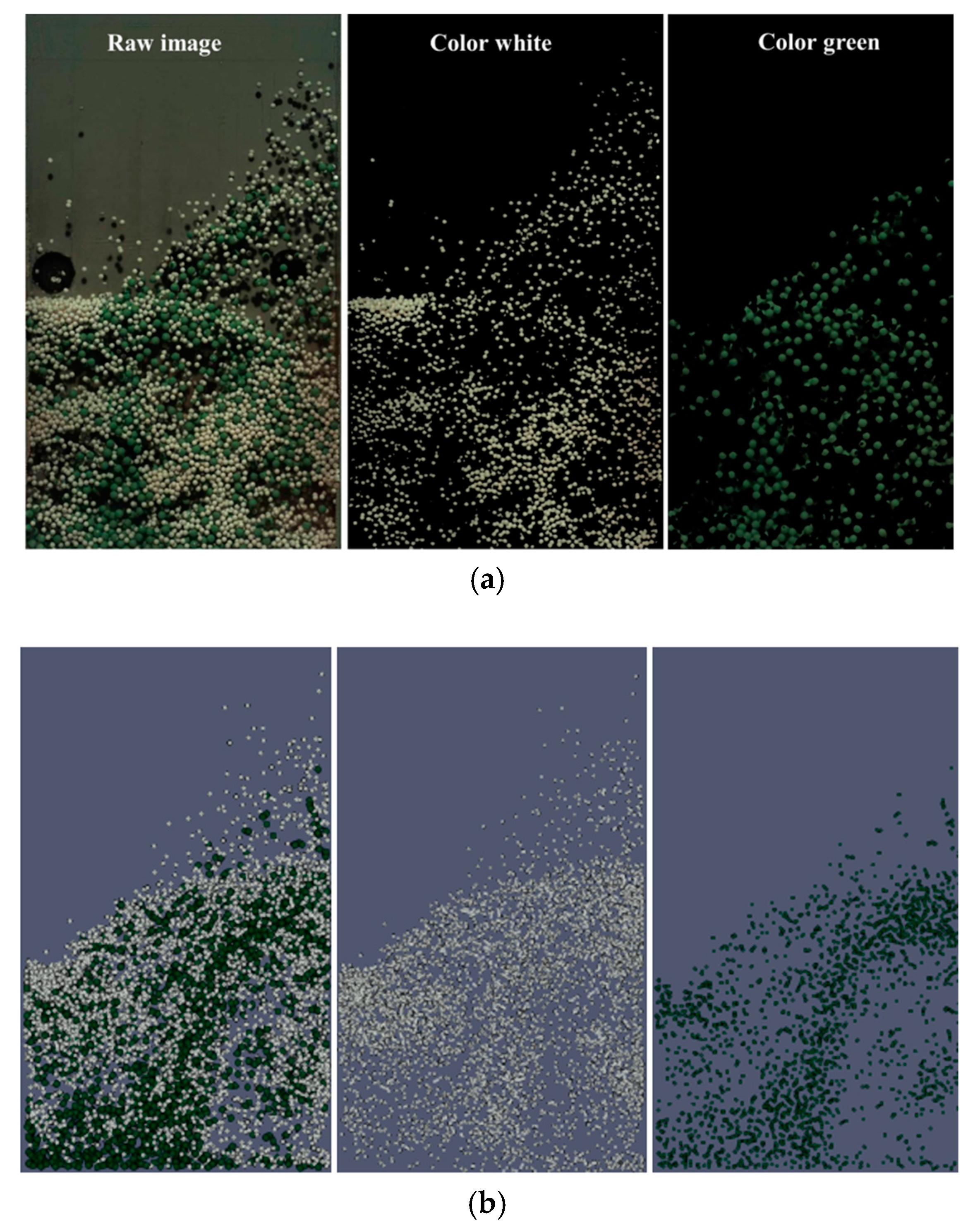
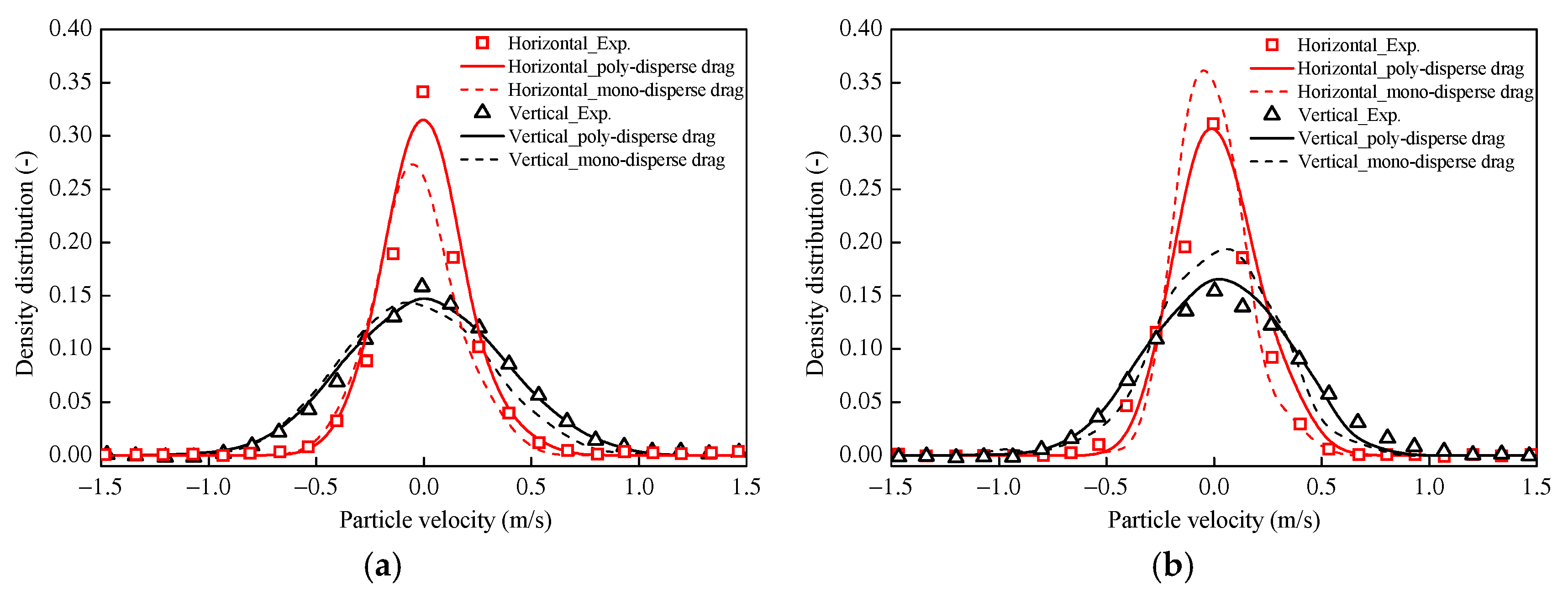


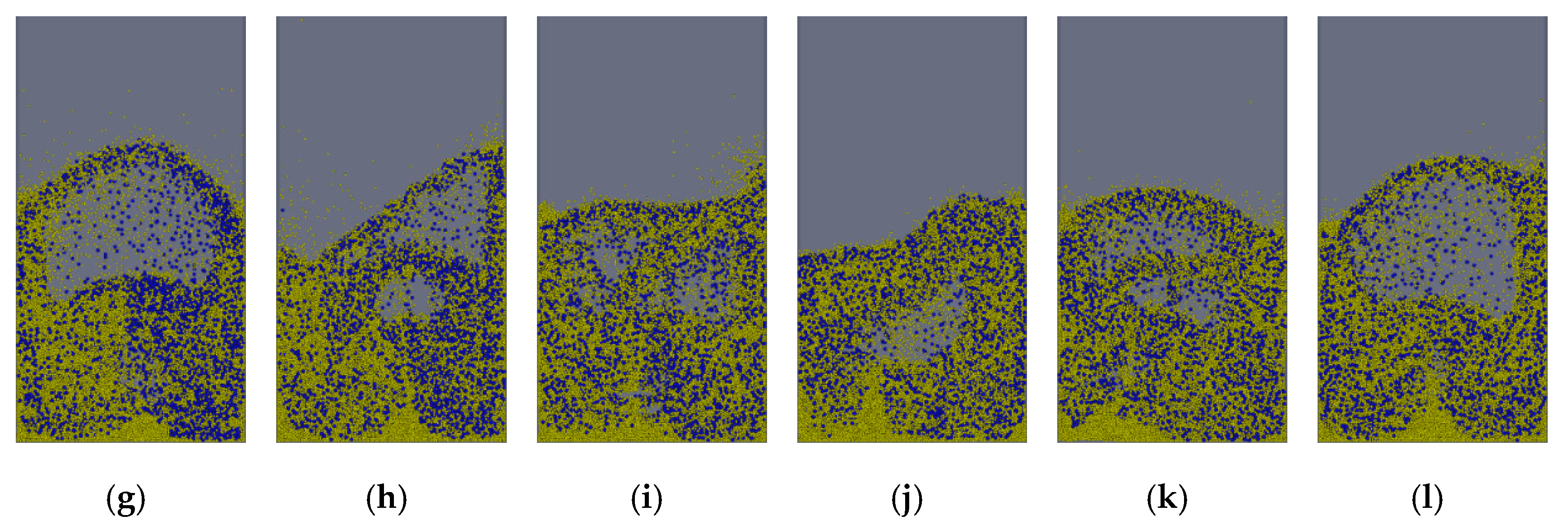
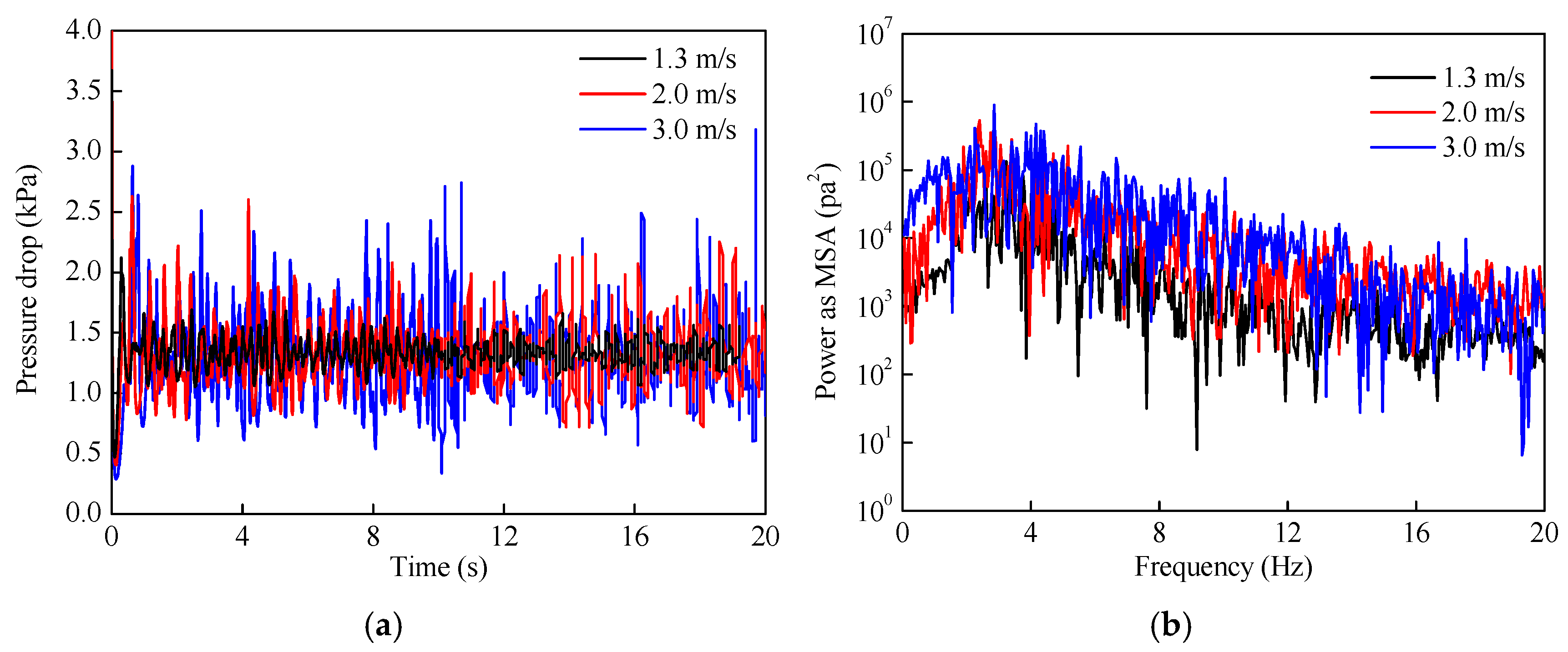

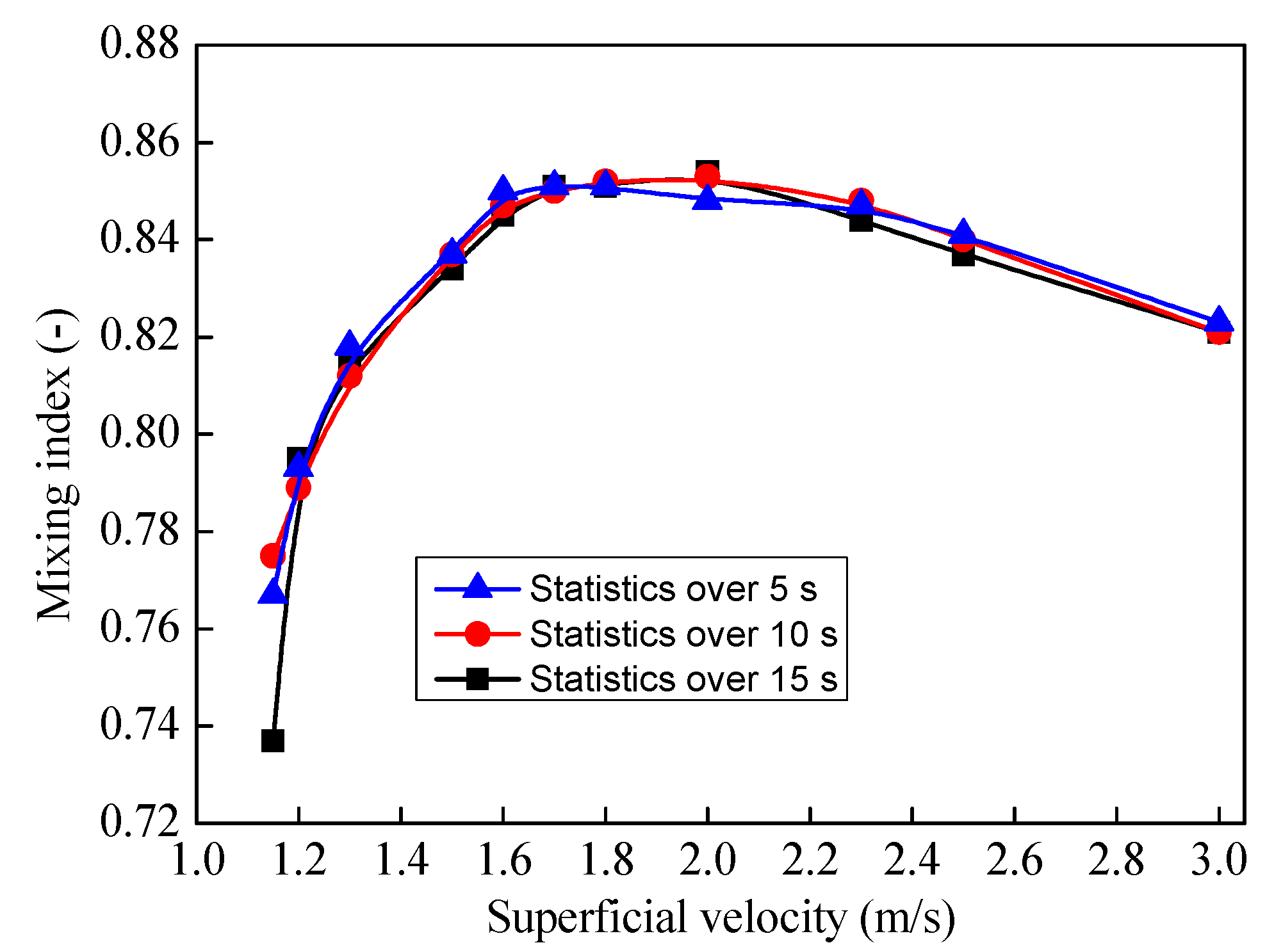
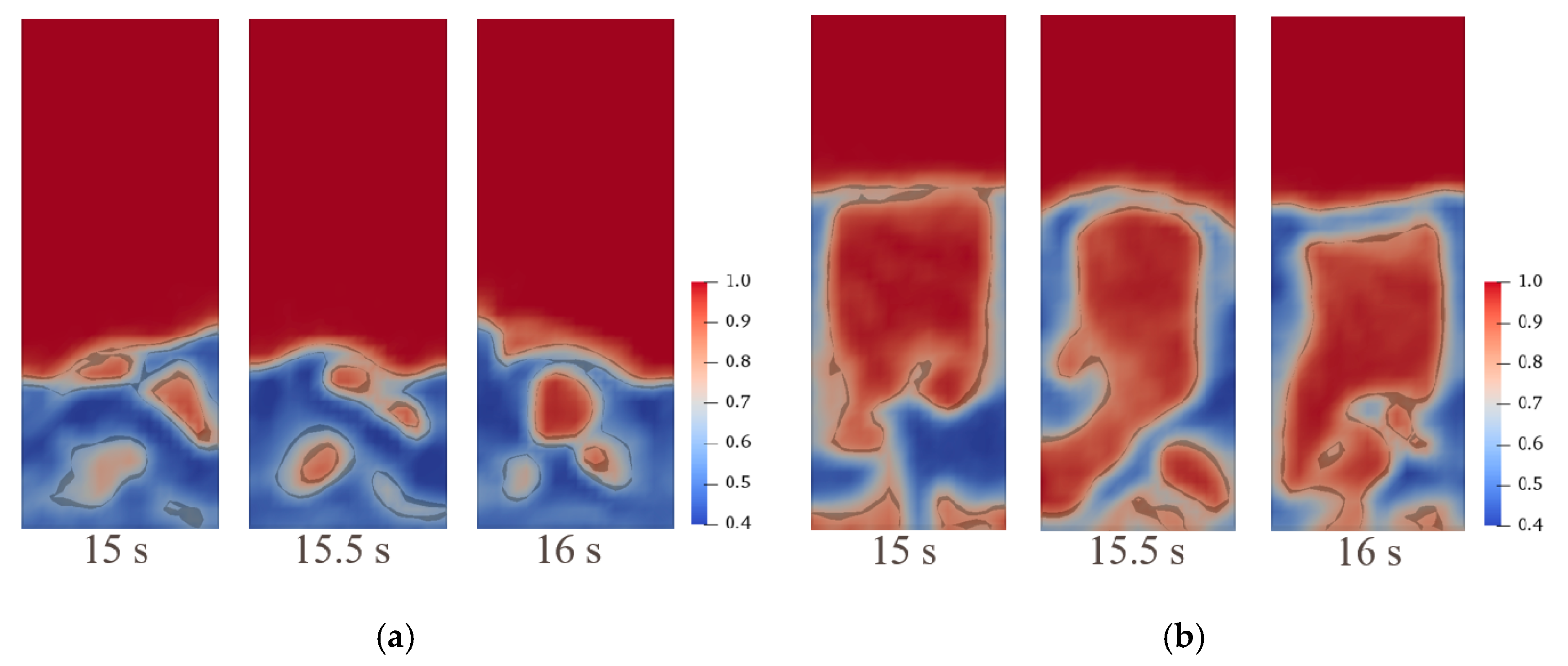
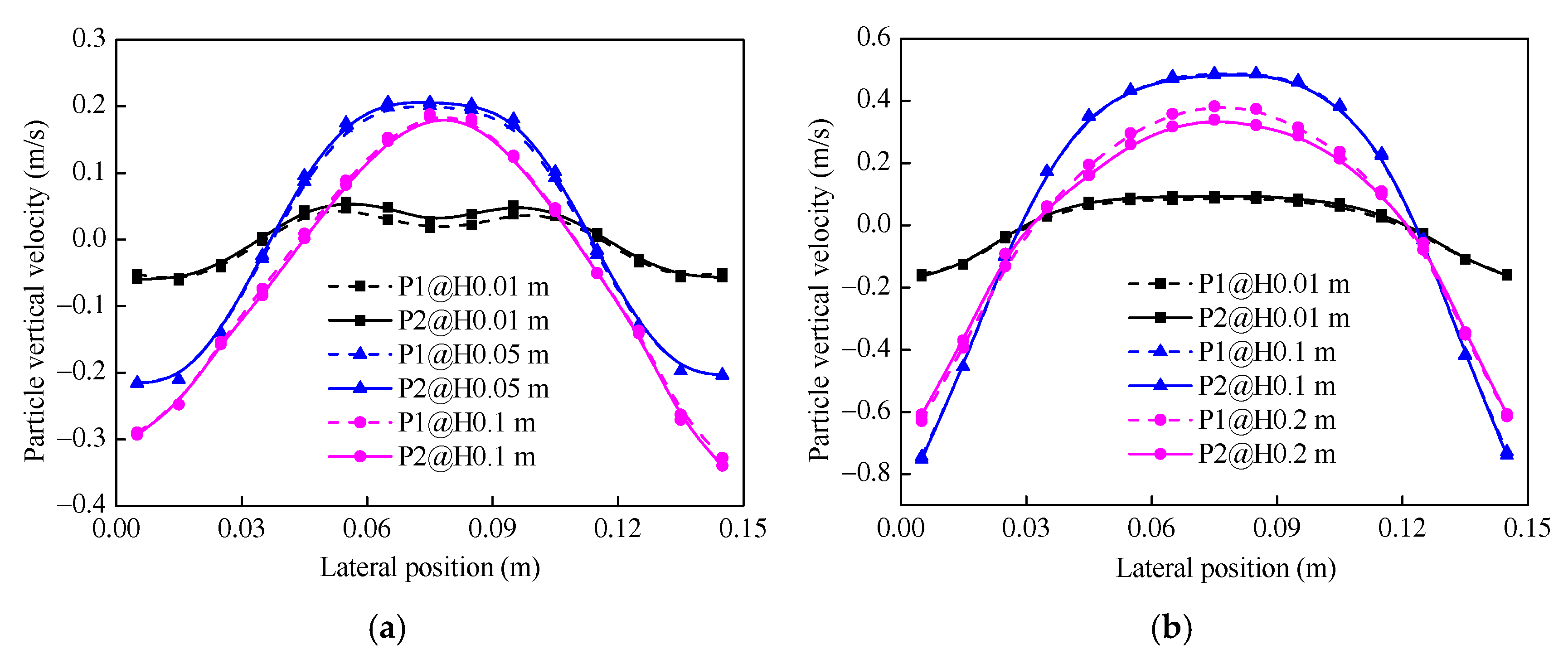
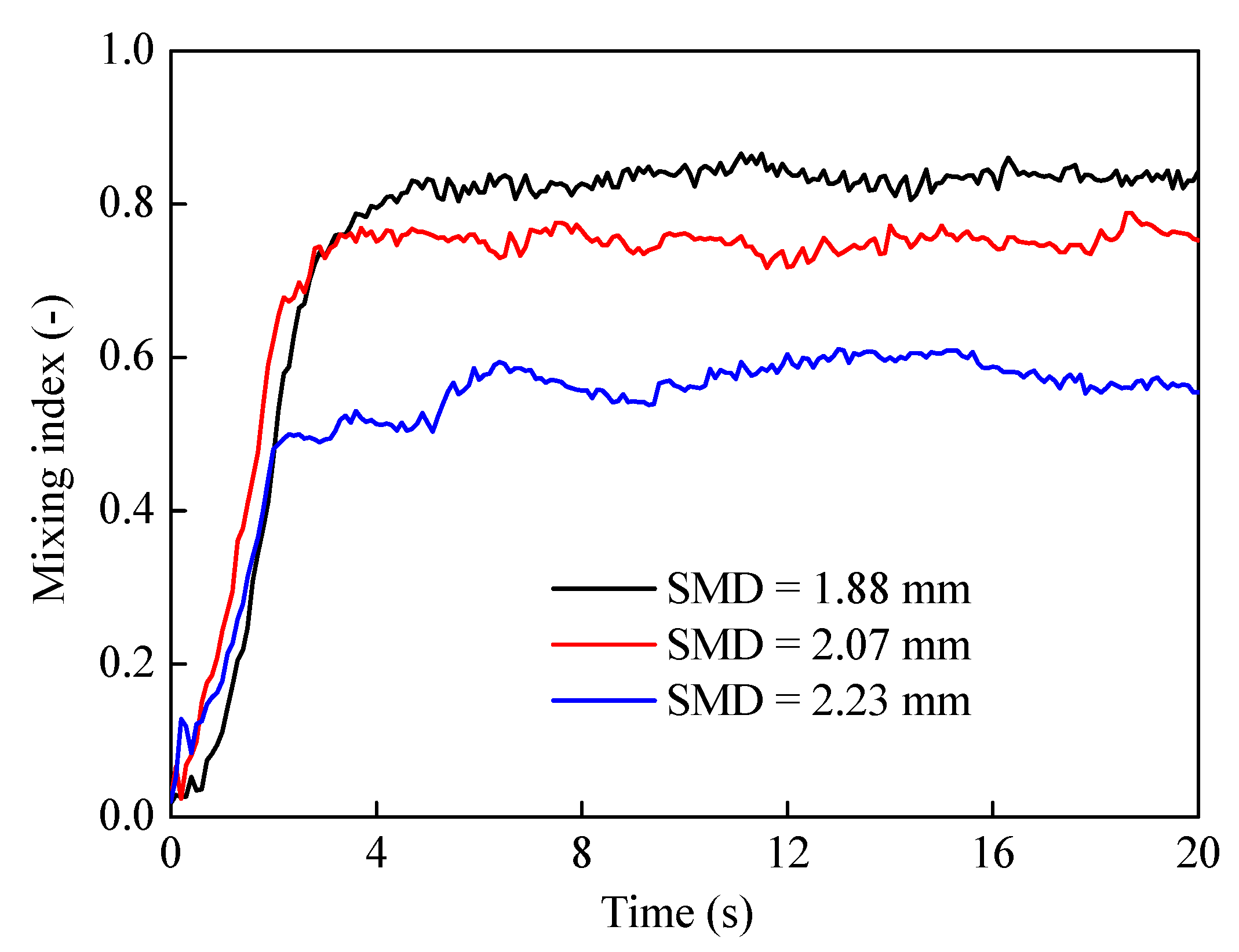

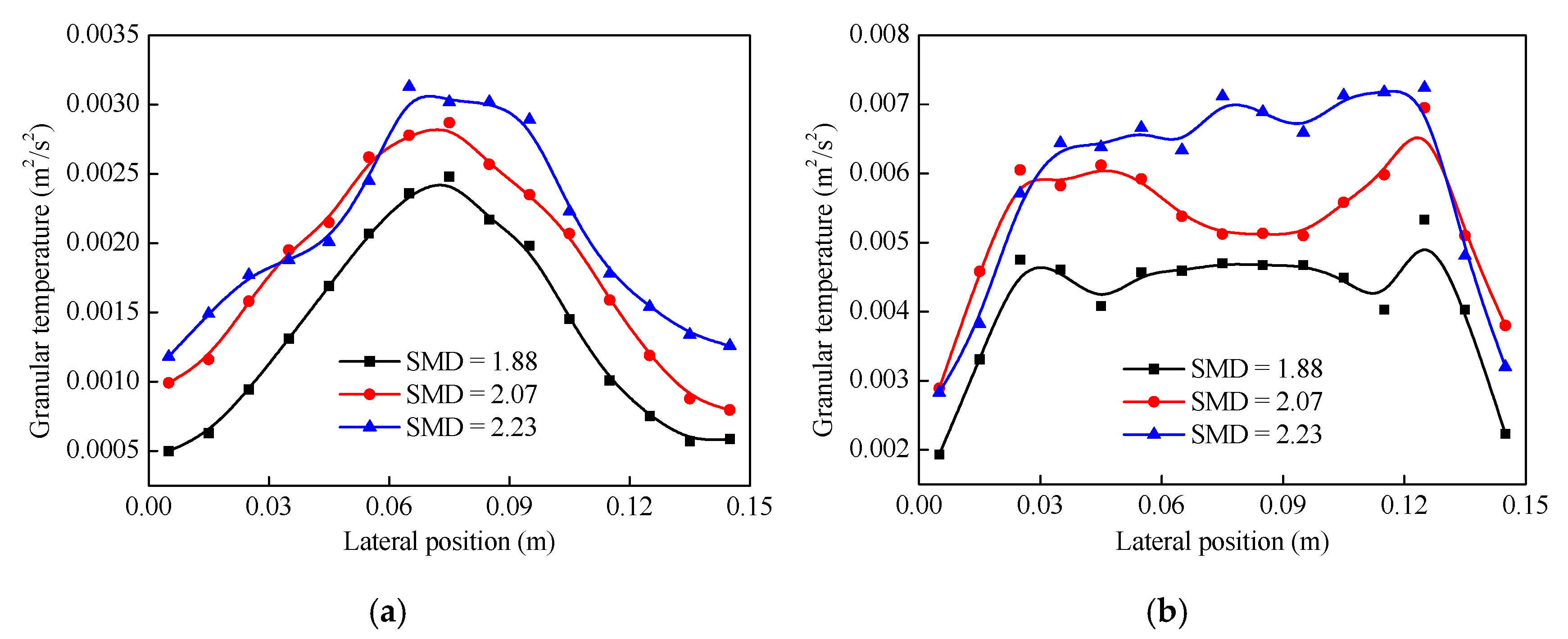
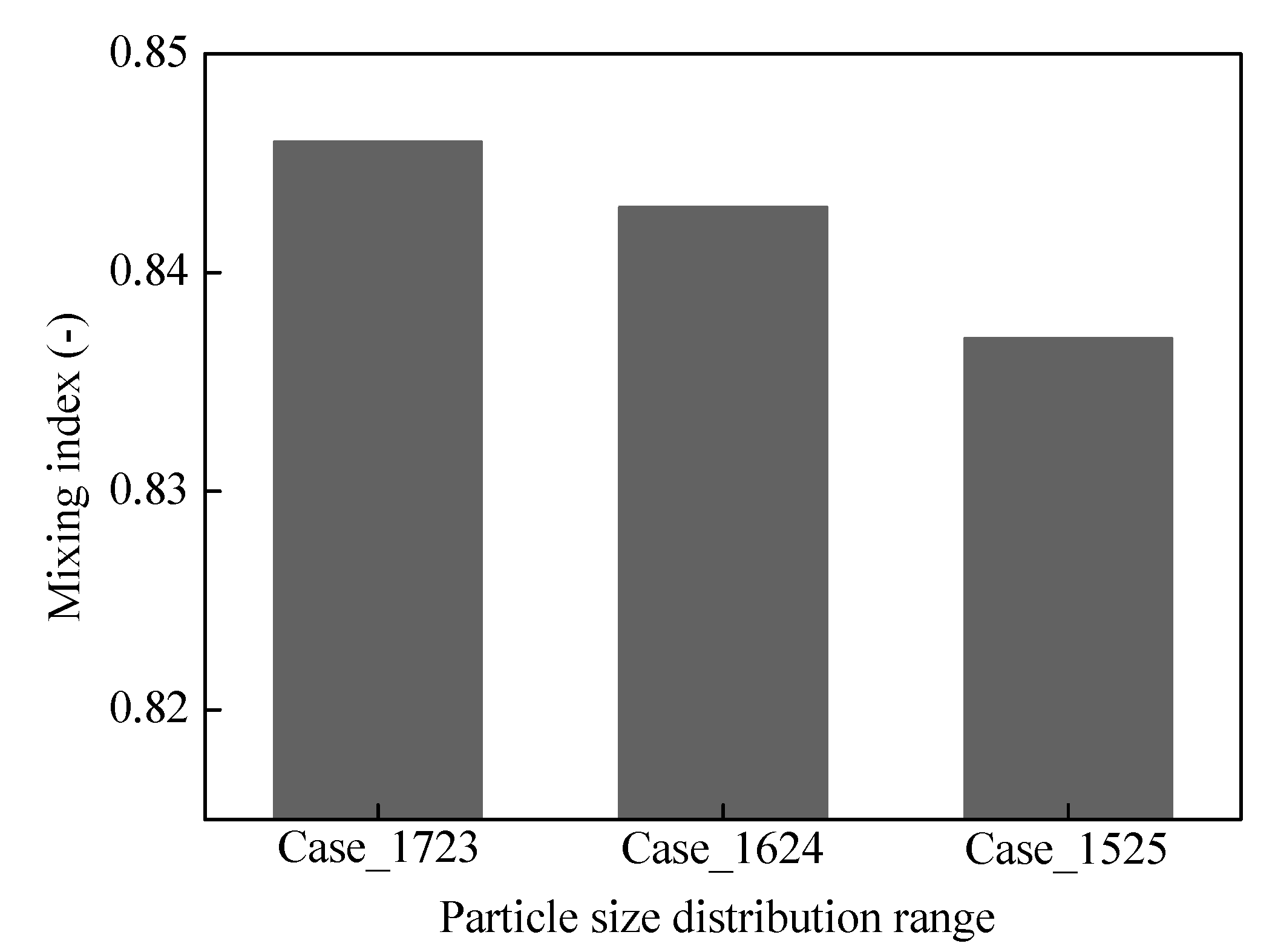
| Properties | Small Particle (P1) | Large Particle (P2) |
|---|---|---|
| Density (g/cm3) | 2.5 | 2.5 |
| Diameter (mm) | 1.5 | 2.5 |
| Number | 37,000 | 8000 |
| Restitution coefficient | 0.97 | 0.97 |
| Friction coefficient | 0.3 | 0.3 |
| Spring constant (N/s) | 800 | 800 |
| Parameters | Value |
|---|---|
| Particle Phase | |
| Diameter (mm) | 1.8 (P1), 2.5 (P2) |
| Density (kg/m3) | 985 (P1), 1450 (P2) |
| Minimum fluidization velocity (m/s) | 0.53 (P1), 0.91 (P2) |
| Bed mass (g) | 13.5 (P1), 20.2 (P2) |
| Restitution coefficient | 0.97 (P1, P2) |
| Friction coefficient | 0.1 (P1, P2) |
| Time step (s) | 1 × 10−7 (P1, P2) |
| Gas Phase | |
| Density (kg/m3) | 1.2 |
| Viscosity (kg/(m·s)) | 1.8 × 10−5 |
| Superficial velocity (m/s) | 2.8 |
| Time step (s) | 1 × 10−5 |
| Parameters | Value |
|---|---|
| Density (g/cm3) | 2.5 (P1, P2) |
| Diameter (mm) | 1.5 (P1), 2.5 (P2) |
| Number in case1 | 37,000 (P1), 8000 (P2) |
| Number in case2 | 23,000 (P1), 11,000 (P2) |
| Number in case3 | 13,800 (P1), 13,000 (P2) |
| Restitution coefficient | 0.97 (P1, P2) |
| Friction coefficient | 0.3 (P1, P2) |
| Spring constant (N/s) | 800 (P1, P2) |
| SMD in case1 (mm) | 1.88 |
| SMD in case2 (mm) | 2.07 |
| SMD in case3 (mm) | 2.23 |
| Gas velocity (m/s) | 1.5 |
| Parameters | Value |
|---|---|
| Density (g/cm3) | 2.5 (P1, P2) |
| Diameter in case 4 (mm) | 1.5 (P1), 2.5 (P2) |
| Number in case 4 | 37,000 (P1), 8000 (P2) |
| Diameter in case 5 (mm) | 1.6 (P1), 2.4 (P2) |
| Number in case 5 | 34,000 (P1), 8000 (P2) |
| Diameter in case 6 (mm) | 1.7 (P1), 2.3 (P2) |
| Number in case 6 | 33,000 (P1), 7000 (P2) |
| Restitution coefficient | 0.97 (P1, P2) |
| Friction coefficient | 0.3 (P1, P2) |
| Spring constant (N/s) | 800 (P1, P2) |
| SMD in case 4 (mm) | 1.88 |
| SMD in case 5 (mm) | 1.88 |
| SMD in case 6 (mm) | 1.88 |
| Gas velocity (m/s) | 1.5 |
© 2020 by the authors. Licensee MDPI, Basel, Switzerland. This article is an open access article distributed under the terms and conditions of the Creative Commons Attribution (CC BY) license (http://creativecommons.org/licenses/by/4.0/).
Share and Cite
Lin, J.; Luo, K.; Wang, S.; Sun, L.; Fan, J. Particle-Scale Simulation of Solid Mixing Characteristics of Binary Particles in a Bubbling Fluidized Bed. Energies 2020, 13, 4442. https://doi.org/10.3390/en13174442
Lin J, Luo K, Wang S, Sun L, Fan J. Particle-Scale Simulation of Solid Mixing Characteristics of Binary Particles in a Bubbling Fluidized Bed. Energies. 2020; 13(17):4442. https://doi.org/10.3390/en13174442
Chicago/Turabian StyleLin, Junjie, Kun Luo, Shuai Wang, Liyan Sun, and Jianren Fan. 2020. "Particle-Scale Simulation of Solid Mixing Characteristics of Binary Particles in a Bubbling Fluidized Bed" Energies 13, no. 17: 4442. https://doi.org/10.3390/en13174442
APA StyleLin, J., Luo, K., Wang, S., Sun, L., & Fan, J. (2020). Particle-Scale Simulation of Solid Mixing Characteristics of Binary Particles in a Bubbling Fluidized Bed. Energies, 13(17), 4442. https://doi.org/10.3390/en13174442






